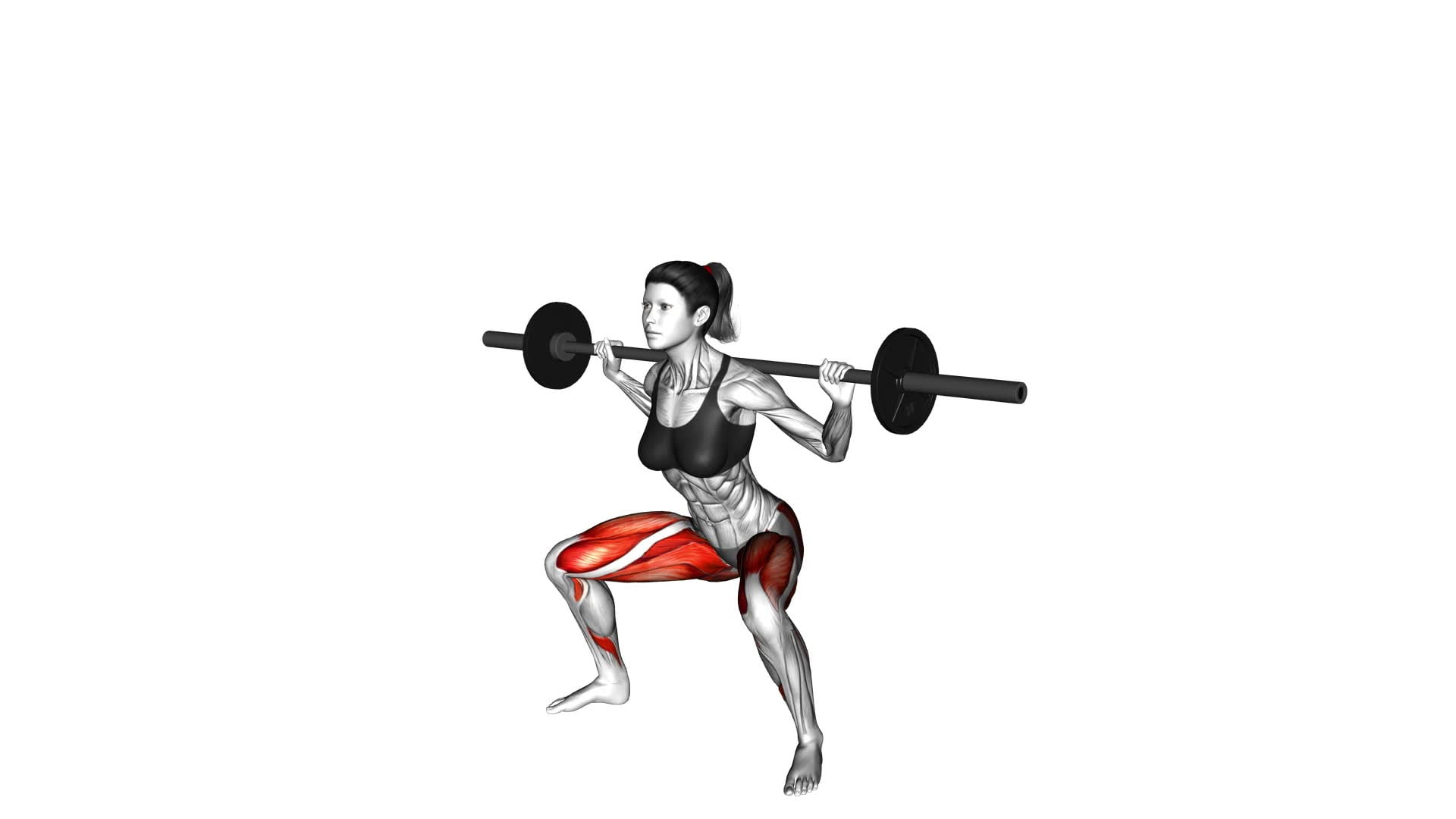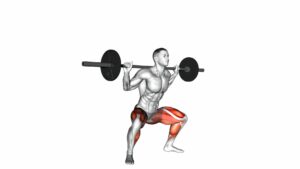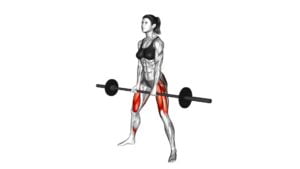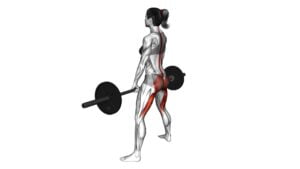Barbell Sumo Squat (female) – Video Exercise Guide & Tips

Are you looking for a challenging lower body exercise? Look no further than the barbell sumo squat!
Watch This Exercise Video
In this exercise, you'll use a barbell and take a wide stance, targeting your glutes, quads, and hamstrings. It's a great way to build strength and tone your legs.
With proper form and technique, you'll be on your way to achieving your fitness goals. Get ready to feel the burn!
Let's dive into the video exercise guide and tips for the barbell sumo squat.
Key Takeaways
- Barbell Sumo Squat targets glutes, quads, and hamstrings.
- Proper form and technique are crucial to prevent injury and maximize benefits.
- Variations and progressions can be incorporated to increase difficulty and target specific muscles.
- Equipment alternatives such as dumbbells or kettlebells can be used for the exercise.
Benefits of Barbell Sumo Squat
Discover the benefits of the barbell sumo squat for a stronger lower body.
The barbell sumo squat, which is a variation of the regular squat, involves taking a wide stance with your feet turned out at an angle. This wide stance targets different muscles than the traditional squat, making it an effective exercise for strengthening your lower body.
One of the main benefits of the barbell sumo squat is that it targets the muscles in your inner thighs, or adductors. By taking a wider stance, you engage these muscles more intensely, helping to build strength and stability in this area. Additionally, the wider stance also targets the glutes and quadriceps, further enhancing the overall leg strength.
Another advantage of the barbell sumo squat is its ability to improve hip mobility. The wide stance requires a greater range of motion in the hips, which can help to increase flexibility and mobility in this area. Improved hip mobility isn't only beneficial for everyday movements but also for other exercises and sports activities.
Proper Form and Technique
To perform the Barbell Sumo Squat with proper form and technique, it's important to focus on hip and knee alignment. Keep your knees in line with your toes and avoid letting them collapse inward.
Additionally, distribute your weight evenly throughout your feet to ensure stability and maximize the effectiveness of the exercise.
Hip and Knee Alignment
Ensure proper hip and knee alignment during the barbell sumo squat by keeping your feet shoulder-width apart and your knees tracking over your toes. This is crucial to prevent injury and maximize the effectiveness of the exercise.
Common mistakes in hip and knee alignment include allowing the knees to cave inwards or extending them too far forward. To avoid these errors, focus on pushing your knees outwards and maintaining a straight line from your hips to your toes.
Variations of the barbell sumo squat can include using dumbbells or a kettlebell instead of a barbell, or incorporating pulses or pauses at the bottom of the squat. Progressions can involve increasing the weight or adding resistance bands to intensify the exercise.
Remember to always prioritize proper form and technique to get the most out of your workout.
Weight Distribution Tips
Are you unsure about how to properly distribute your weight during the barbell sumo squat? It's important to have the correct weight distribution to ensure proper form and technique.
When performing the barbell sumo squat, you want to distribute your weight evenly between your feet. This means keeping your feet flat on the ground and pushing through your heels as you squat down.
It's also crucial to engage your core and maintain a neutral spine throughout the exercise to prevent any unnecessary strain on your back.
Additionally, understanding proper weight distribution for the barbell sumo squat can also help you with other exercises that require similar form, such as deadlifts and lunges.
Equipment Needed for the Exercise
To perform the barbell sumo squat exercise, you'll need some essential equipment.
First and foremost, you'll need a barbell with weights that you can comfortably handle.
Additionally, it's recommended to use a squat rack or a power rack to safely load and unload the barbell.
If you don't have access to these specific equipment, there are alternatives you can consider, such as using dumbbells or kettlebells instead of a barbell.
Essential Equipment for Exercise
You will need a barbell for the Barbell Sumo Squat exercise. The barbell is a crucial piece of equipment that adds resistance to the exercise, helping to strengthen your legs and glutes.
It's important to choose a barbell that's the right weight for your fitness level and goals. When it comes to exercise equipment, there are many brands to choose from. Some of the best brands for exercise equipment include Rogue Fitness, Eleiko, and Titan Fitness. These brands are known for their high-quality and durable products that can withstand heavy use.
If you don't have access to a barbell, there are alternative exercises you can do, such as dumbbell sumo squats or kettlebell sumo squats, which can provide similar benefits.
Alternatives to Required Equipment
If you don't have access to a barbell, consider using dumbbells or kettlebells as alternatives for the Barbell Sumo Squat exercise. Dumbbells and kettlebells can provide a similar level of resistance and can be held in each hand while performing the exercise.
To do this, hold one dumbbell or kettlebell in each hand at your sides, with your palms facing inwards. Bend your knees and lower your body into a squat position, keeping your back straight and your chest up. Push through your heels to stand back up and repeat the movement.
Alternatively, if you prefer bodyweight exercises, you can perform sumo squats without any additional weight. Another option is to use resistance bands, which can be wrapped around your thighs or held in your hands to provide resistance during the exercise.
Common Mistakes to Avoid
Avoid lifting too heavy of a weight during the barbell sumo squat exercise. This is important to prevent injuries and ensure proper form. Here are some common mistakes to avoid:
- Using improper form: Make sure to keep your back straight, chest up, and knees tracking over your toes throughout the movement. Avoid rounding your back or letting your knees cave in.
- Not warming up properly: Always warm up your muscles before performing any exercise, especially ones that target your lower body. This can help prevent injuries and improve your overall performance.
- Neglecting modifications and regressions: If you're a beginner or have any physical limitations, it's important to modify the exercise to suit your needs. You can start with bodyweight sumo squats or use a lighter weight until you build up strength and stability.
- Rushing the movement: Take your time and focus on performing the exercise with control and proper technique. Avoid jerking or bouncing during the squat motion.
By avoiding these common mistakes, you can maximize the benefits of the barbell sumo squat exercise and reduce the risk of injury.
Now, let's move on to discussing variations and progressions to keep challenging yourself and making progress.
Variations and Progressions
To add variety and challenge to your workout, try incorporating different variations and progressions of the barbell sumo squat exercise.
By modifying the exercise, you can target specific muscle groups and continue to challenge your body.
One variation you can try is the goblet sumo squat, where you hold a dumbbell or kettlebell in front of your chest as you perform the squat. This variation places more emphasis on your quads and glutes.
Another modification is the single leg sumo squat, where you perform the exercise on one leg at a time. This engages your stabilizer muscles and increases the intensity of the exercise.
Additionally, you can progress to a barbell front sumo squat or a barbell back sumo squat. The front squat variation places more emphasis on your quads, while the back squat variation targets your glutes and hamstrings.
Remember to start with lighter weights and focus on maintaining proper form before progressing to heavier weights or more challenging variations.
Tips for a Safe and Effective Workout
To ensure a safe and effective workout, continue to challenge your body by incorporating different variations and progressions of the barbell sumo squat exercise. Here are some tips for beginners and warm-up exercises to help you get the most out of your workout:
Tips for beginners:
- Start with lighter weights and gradually increase the load as you gain strength and confidence.
- Focus on maintaining proper form throughout the movement to prevent injury. Keep your back straight, chest up, and knees tracking over your toes.
Warm-up exercises:
- Dynamic stretches: Perform exercises like leg swings, hip circles, and walking lunges to warm up your lower body and increase flexibility.
- Activation exercises: Engage your glutes and core muscles with exercises like glute bridges, clamshells, and planks. This will help stabilize your body during the barbell sumo squat.
By following these tips for beginners and incorporating warm-up exercises into your routine, you can reduce the risk of injury and maximize the benefits of the barbell sumo squat. Remember to listen to your body and adjust the intensity and weight according to your fitness level.
Happy squatting!
Frequently Asked Questions
How Many Sets and Reps Should I Do When Performing the Barbell Sumo Squat?
When performing the barbell sumo squat, it's important to find the right balance between sets and reps.
You'll want to start with a weight that challenges you but allows for proper form.
A good starting point is 3 sets of 8-12 reps.
As you become more comfortable and stronger, you can increase the weight and decrease the reps to 3 sets of 6-8 reps.
Remember to listen to your body and make modifications as needed to avoid injury.
Can I Do the Barbell Sumo Squat if I Have Knee or Hip Problems?
If you have knee or hip problems, it's important to be cautious when doing the barbell sumo squat. There are alternative exercises that can be done to target the same muscles without putting stress on your joints.
Additionally, modifications can be made to the barbell sumo squat to make it more knee and hip-friendly, such as using lighter weights or adjusting your stance.
It's always best to consult with a professional trainer or physical therapist for personalized modifications and recommendations.
Is It Necessary to Use a Barbell for the Sumo Squat, or Can I Use Other Equipment Like Dumbbells or Kettlebells?
You don't have to use a barbell for sumo squats. Other equipment like dumbbells or kettlebells can be used too. Incorporating alternative equipment for sumo squats can add variety to your workout routine and target different muscle groups.
Sumo squats are beneficial for building lower body strength, improving posture, and increasing hip mobility. Including sumo squats in your routine can help you achieve a well-rounded workout and achieve your fitness goals.
Should I Warm up Before Doing the Barbell Sumo Squat, and if So, What Are Some Recommended Warm-Up Exercises?
Before performing the barbell sumo squat, it's important to warm up to prevent injury and optimize your workout.
Some recommended warm-up exercises include dynamic stretches, such as leg swings and hip circles, to increase flexibility and range of motion.
Additionally, performing bodyweight squats or lunges can help activate the muscles you'll be targeting during the barbell sumo squat.
Incorporating warm-up exercises will prepare your body for the workout and enhance the benefits of incorporating barbell sumo squats in your routine.
What Muscles Does the Barbell Sumo Squat Primarily Target, and Are There Any Secondary Muscle Groups That Are Also Engaged?
The barbell sumo squat primarily targets your quadriceps, glutes, and adductor muscles. These are the main muscle groups that get a good workout from this exercise. However, there are also secondary muscle groups that are engaged, such as your hamstrings, calves, and core muscles.
It's important to note that there are variations of the sumo squat for different fitness levels, so you can adjust the difficulty according to your needs.
Conclusion
In conclusion, the barbell sumo squat is a highly effective exercise for women that offers a range of benefits.
By using proper form and technique, and with the necessary equipment, this exercise can target multiple muscle groups, including the glutes, quadriceps, and hamstrings.
It's important to avoid common mistakes and to gradually progress in difficulty.
With these tips in mind, you can safely and effectively incorporate the barbell sumo squat into your workout routine.

Author
Years ago, the spark of my life’s passion ignited in my mind the moment I stepped into the local gym for the first time. The inaugural bead of perspiration, the initial endeavor, the very first surge of endorphins, and a sense of pride that washed over me post-workout marked the beginning of my deep-seated interest in strength sports, fitness, and sports nutrition. This very curiosity blossomed rapidly into a profound fascination, propelling me to earn a Master’s degree in Physical Education from the Academy of Physical Education in Krakow, followed by a Sports Manager diploma from the Jagiellonian University. My journey of growth led me to gain more specialized qualifications, such as being a certified personal trainer with a focus on sports dietetics, a lifeguard, and an instructor for wellness and corrective gymnastics. Theoretical knowledge paired seamlessly with practical experience, reinforcing my belief that the transformation of individuals under my guidance was also a reflection of my personal growth. This belief holds true even today. Each day, I strive to push the boundaries and explore new realms. These realms gently elevate me to greater heights. The unique combination of passion for my field and the continuous quest for growth fuels my drive to break new ground.



